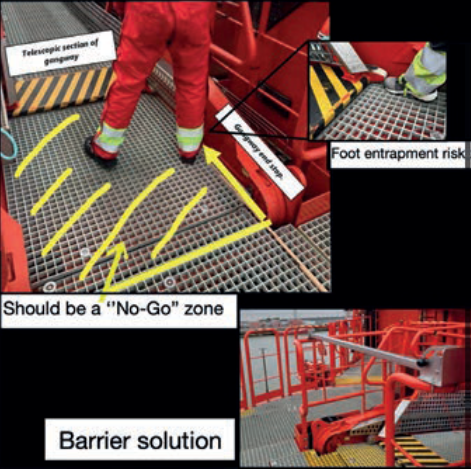202455 Crushed foot leaves lasting imprint
As edited from Marine Safety Forum/ Safety Alert 15/05/2024 LTI – Compound Fracture of Right Foot
An offshore windfarm Service Operation Vessel (SOV) was positioned at a wind turbine generator (WTG). Waves of 3m and a swell of 2.8m were being experienced but this was deemed acceptable. With the vessel in an optimal position relative to the connection point on the WTG and the prevailing weather, the gangway operator was given permission to make the gangway connection.
The gangway operator stood at the base of the telescoping access bridge and used the mobile remote control to operate the gangway and make the connection in the usual fashion. Due to the vessel movement, he had difficulty in making the connection and retracted the gangway to re-assess the weather conditions.
The weather conditions were determined to be within the capabilities of the gangway system and SOV, so a second attempt was made to connect. The gangway operator was again unable to make the connection and retracted the gangway. During this retraction, the telescoping section of the gangway frame travelled over the gangway operators’ right foot, trapping it, and causing a compound fracture of the foot.
The investigation found, among other things, that the final section of the travel path (soft stop) for the gangway frame was not guarded. Additionally, the gangway operator’s training had reinforced the practice of standing on the Telescope Access Bridge platform or in the operator shelter during gangway connection attempts, thus normalising the operators to this practice.

Lessons learned
-
Guarding was installed along the exposed soft stop of the gangway to ensure a person cannot place their feet in the path of the retracting gangway frame.
-
A physical barrier was installed at the base of the telescopic gangway section which prevents the operator from encountering the gangway when it is fully retracted.
- Gangway operator training program was updated with specific focus on entrapment and shearing potential areas on the gangway.
- Develop a set of sea state/vessel movement limits for gangway connections that the gangway operators can use as guidance to make an informed decision on when to stop the job independent of the vessel’s station keeping abilities.
